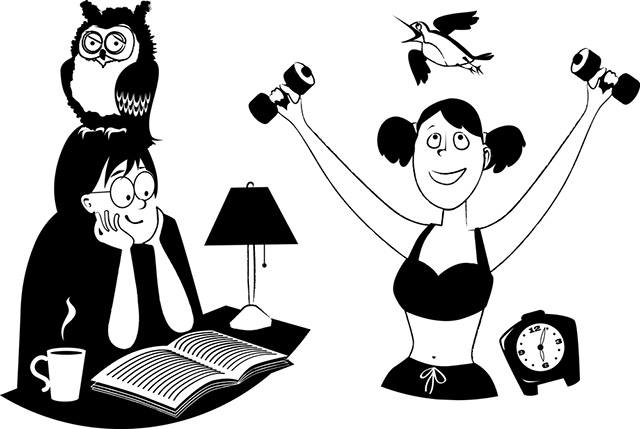Throughout time, people have sought out to increase their productivity levels. Now that entrepreneurship is an inspiring dream for a lot of people, productivity hacks are on the rise more than ever, leading to all sorts of solutions to stay focused, break apart from the social media bubble, start the day doing one difficult thing, adhering to GTD systems, or making sleep time more efficient to spend more hours awake.
Generally speaking, biology and neuroscience have educated people that it is crucial to get at least seven hours of interrupted sleep each night. Sleeping in a single take over a 24 hour period is called monophasic sleep, but there’s also polyphasic sleep, which basically translated into diving your day to take multiple naps in hopes of increasing the period of time one can spend awake.
What Is the Everyman Cycle?
One of the most famous types of polyphasic sleep is Uberman. It was first named by Marie Staver (Puredoxyk) back in 1999. It is a very difficult schedule to adopt because it consists of short 20-minute naps taken once every four hours, which basically means a total of two hours of sleep in a 24-hour day.
When the concept first appeared, it was said that it takes people about one week to become adjusted to this schedule, but the results didn’t even come close. The difficulty of the Uberman schedule made people feel terrible, with the impossibility to have their bodies adjust to six naps scattered throughout the day.
The Everyman sleep schedule was created as an attempt to modify the Uberman sleep cycle and make it a bit easier, thus introducing a core sleep between a number of naps throughout the day. The Everyman sleep cycle is designed to help people get adjusted easier to sleeping fewer hours per day.
You may want to read: The Uberman Sleep Cycle
Understanding Sleep Phases
People have four different sleep stages: three of them are non-REM and the fourth is REM sleep. Each of them has different characteristics and, once you understand what happens during each phase, you will be able to analyze the Everyman sleep cycle on a whole new level:
- Stage 1: This is the lightest type of sleep. When you doze off and are in this first stage, you can easily be woken up. During stage 1, you experience slow eye movements, and feel drowsy rather than be fully asleep. This is when your muscles are just barely starting to relax and your brain wave activity shifts from being fully awake to falling asleep. You might experience what is known as a hypnic jerk, which is involuntary twitching and muscle spasms. It’s also not uncommon for people who are in the first sleeping stage to feel like they’re falling.
- Stage 2: This is the first stage of actual sleep. You are in a deeper sleep than the one experienced in the first stage, which makes it less likely for you to be easily woken up. During this stage, you will experience sleep spindles, which are rapid bursts of brain activity, and K complexes, which are sleep structures. Without too many scientific explanations, K complexes and sleep spindles have the role of making sure the brain is protected from awakening while you are asleep. During the second stage, your body temperature starts to drop, and your heart rate is significantly slower.
- Stage 3: This is commonly referred to as the stage of deep sleep. This is when your muscles are fully relaxed, and your breathing slows down. Your brain waves are very slow, and your body enters the restorative stage. During your deep sleep phase, you are unlikely to wake up unless you hear loud noises. Deep sleep is sometimes called delta sleep or slow-wave sleep. This is when growth hormones are released, and your body unwinds from the stress experienced during the day. In slow-wave sleep, your sleep drive is reduced. You may have noticed that even if you take naps during the day, you can still fall asleep easily during the night. That’s because naps don’t go all the way to the deep sleep stage. On the other hand, if you nap during the day for long enough, you will experience deep sleep, which reduces your need to sleep, thus making it more difficult to sleep at night.
- Stage 4: This stage is known as REM, which is short for “rapid eye movement”. It is one of the most studies sleep stages of all, because it is the dreaming stage. Compared to stage 3, you can wake up easier from the REM sleep stage, but if you do wake up, you are likely to feel very sleepy. Throughout their entire sleep cycle, a person can experience three to five REM periods, with the longest one being before they’re ready to wake up. When you’re in the REM sleep stage, you will breathe faster, your muscles feel paralyzed, and your eyes move really fast. The brain waves of a person in their REM sleep stage are similar to those of a person who is awake.
Types of Everyman Sleep Cycles
When people attempted to adjust to the Uberman schedule, the result was an uncontrollable crash. In order to optimize these sleeping schedules, Everyman was born. It has adjusted variations with different core sleep periods and naps spread throughout the day.
Everyman 1
The E1 sleep cycle consists of a total of six hours and 20 minutes of sleep each day. The core sleeping period is six hours long, with a 20-minute nap during the day, after eight hours of activity. The E1 is easier to implement compared to other sleeping schedules, and consist of a long-core sleep and one REM nap.
The Everyman 1 sleep cycle is great for just about anyone who is willing to try it, provided that person has 20 minutes available somewhere around lunch-time in order to take that power nap.
Everyman 2
E2 is another adaptation of the Everyman sleep cycle, with a core sleep of four and a half hours, plus two naps of 20 minutes each, leading to a total sleep time of five hours and ten minutes throughout the entire day. It has a moderate adaptation difficulty, with one long-core sleep and two REM naps.
Everyman 2 might work really well for students to have the ability to nap before and after classes, as well as in between. It’s also good for people who have part-time jobs that give them the freedom of sleeping twice throughout the day.
Everyman 3
Moving on, we have the more difficult E3 sleeping schedule, which consists of four hours of sleep in a 24-hour cycle, with one core nap of three hours, and then another three naps of 20 minutes each. Today, E3 is one of the most difficult Everyman schedules to attempt, which is why people attempt different variations, such as prolonging the core sleep up to three hours and 30 minutes.
Everyman 4
The E4 sleeping schedule is even more difficult compared to the E3. It consists of one core sleep of an hour and a half and four naps of 20 minutes each, leading to a total sleep time of two hours and 50 minutes.
You may be interested in: Everything You Need to Know About a Sleep Cycle Calculator
Pros of the Everyman Sleep Cycle
Before you tackle the idea of completely changing your sleep pattern, it’s important to weigh the advantages and disadvantages of adhering to this sleeping style. Some of the benefits of adopting the Everyman sleep cycle are:
- Reducing sleeping hours to spend more time awake which, theoretically, should lead to increased productivity.
- The possibility to have more free time for personal activities and hobbies.
- The opportunity to engage in deeper sleep because of sleep deprivation.
- It offers the possibility to adjust to different working schedules, which could be beneficial for those who have disrupted circadian rhythms due to working in shifts.
- Gives the possibility to reset the adenosine levels several times a day. Adenosine is a chemical found in all the body cells, which is used for energy transfer. It is considered to be a natural painkiller produced by the body, which also helps widen blood vessels and regulate heart patterns.
- Increases the possibility of one having lucid dreams as a consequence of REM sleep fragmentation.
Drawbacks of the Everyman Sleep Cycle

- The body may not get adjusted to getting only four hours of sleep for every 24 hours in a day. This could lead to sleep deprivation, which takes a toll on the body and the mind, putting one’s immune system at risk.
- It can impact one’s appetite, can increase the possibility of mood changes, and can negatively impact someone with bipolar disorder, pushing them towards episodes of mania.
- It can affect hormone release, which is an impediment to growth in children and young adults. It can also cause an imbalance in other hormones, such as leptin, ghrelin, or thyroid.
- It increases the chances of people becoming addicted to caffeine as they try to adjust to sleeping only a few hours per day.
- It can affect one’s relationships, as adopting the Everyman sleep schedule implies having different periods of sleep and awakening compared to the others around you.
It’s important to note that the drawbacks of the Everyman sleep cycle will be very different from one person to another, but that many doctors would not recommend people trying to adopt this different sleeping pattern. While it’s true that there are people who can feel rested without having a full eight hours of sleep, most people will feel extremely tired and over-exert themselves without having the guarantee that their body and mind can actually adjust to this type of sleep cycle.
You may want to read: How Does the Sleep Cycle Determine Sleep Quality?
Bottom Line
The Everyman sleep cycle was designed to be an easier-to-implement version of the Uberman. It’s meant to increase the time you spend awake in order to have more personal and professional time. However, there are plenty of challenges and potential drawbacks to switching your sleeping schedule with a completely new one.
If you too are tempted to try sleeping less and diving your sleep into several chunks throughout the day, you have to carefully consider whether your body will be able to handle the challenge, as well as take into account the possibility of sleep deprivation, which can have negative consequences on both a physical and a mental level.



